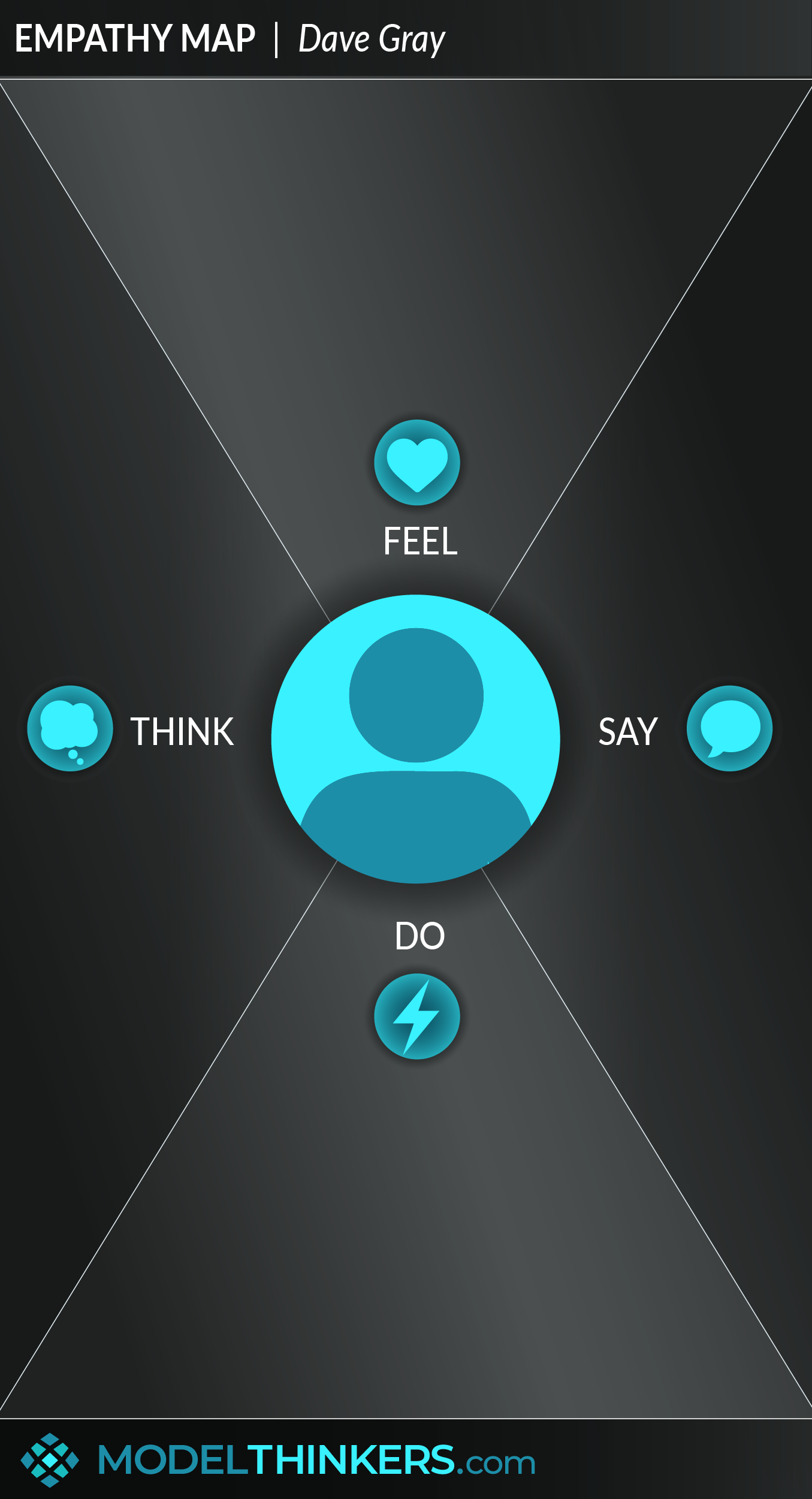

 0 saved
0 saved
 23.6K views
23.6K views








Are you trying to reframe a problem or understand needs by embracing empathy? Then it might be worth considering the wise words of Billy Connolly: “Before you judge a man, walk a mile in his shoes. After that who cares?… He’s a mile away and you’ve got his shoes!” – Billy Connolly
But seriously, in these days of empathy-driven customer-centricity, Empathy Maps represent quick, visual tools that can be used stand-alone or in conjunction with Personas, often as part of a Design Thinking Process.
An Empathy Map is a visual tool used to understand and capture user needs, typically describing what a user feels, thinks, says and does.
A CO-DESIGN TOOL.
An Empathy Map might be used as part of a co-design workshop to generate and distil information about a user, or more commonly as a visual summary to represent user analysis. Such analysis might have been generated from co-design sessions with members of the target group, observation, interviews, surveys, or analysis of user behaviour data.
While traditionally used for design, Empathy Maps can also be used to develop a deeper understanding of peoples' needs in other contexts such as leadership and collaboration.
QUADRANTS.
Empathy Maps generally consist of four quadrants. For example, if rolling out a new system for employees, the response might be as follows:
- Feels: their emotional response.
- Thinks: their inner, unfiltered voice.
- Says: what they share out loud.
- Does: their action and actual behaviour.
THE UPDATE.
While these four elements tend to be the popular approach to empathy mapping, Dave Gray, the creator of Empathy Mapping, has updated his original version as shown below.




- Define the scope and problem.
Identify the problem you are trying to solve and/ or issue you are trying to investigate.
- Establish where an empathy map might fit in.
You might use it as a tool to gather information or share information to the design team and/or key stakeholders. Or both. Consider what is most useful in your situation.
- Establish the persona or approach.
Empathy maps are commonly used in conjunction with Personas. If personas have not been developed, consider which segments or parts of your audience group would be most useful to represent via empathy mapping.
- Gather quantitative and qualitative data.
Identify information sources. While quantitative data might inform your choices, especially around ‘does’, the other elements are best informed through qualitative interviews.
- Identify patterns and insights.
Once the data and information is collected, it is time to sort through it and identify high level insights or patterns. A common approach to this is using card sorts on an Empathy Map framework. First capturing the data on separate sticky notes (physical or virtual), before sorting, clustering, and summarising them to distill the main takeaways in each quadrant.
As with any investigation and summary takeaways about users or user behaviours, this approach is open to unconscious bias and misinterpretation of data, especially what are often limited qualitative data sets or investigation.
As such, they should be seen as hypothesis and not substitute for iterative testing and real engagement with users.
IBM using empathy maps.
IBM provides this example as part of a stepped description of how they use Empathy Maps as part of their design thinking approach. See the full worked example here.
Empathy maps are generally used as part of a broader design thinking approach, particularly in conjunction with personas and journey maps.
Use the following examples of connected and complementary models to weave empathy maps into your broader latticework of mental models. Alternatively, discover your own connections by exploring the category list above.
Connected models:
- Design thinking: the ‘umbrella’ model and framework that captures this and other user-centric approaches.
- Personas: often incorporate empathy maps, or a truncated form of them.
- Journey maps: describing these elements as mapped over an experience.
- Jobs to be done: a variation on personas focused on context and goals, which can be incorporated into empathy maps.
Complementary models:
- Agile methodology and lean startup: empathy maps can be used to quickly communicate user reactions to new products or initiatives.
- Confirmation bias: consider the impact of this on generating empathy maps.
- 5 whys: use why questions in user interviews to help uncover underlying needs.
Empathy Maps were originally created by Dave Gray, a consultant in visual thinking who you can find out more about here. You can also view his popular book Gamestorming here which describes the broader toolkit he envisioned, of which Empathy Maps are a part.
 My Notes
My Notes
Oops, That’s Members’ Only!
Fortunately, it only costs US$5/month to Join ModelThinkers and access everything so that you can rapidly discover, learn, and apply the world’s most powerful ideas.
ModelThinkers membership at a glance:






“Yeah, we hate pop ups too. But we wanted to let you know that, with ModelThinkers, we’re making it easier for you to adapt, innovate and create value. We hope you’ll join us and the growing community of ModelThinkers today.”







































































































































